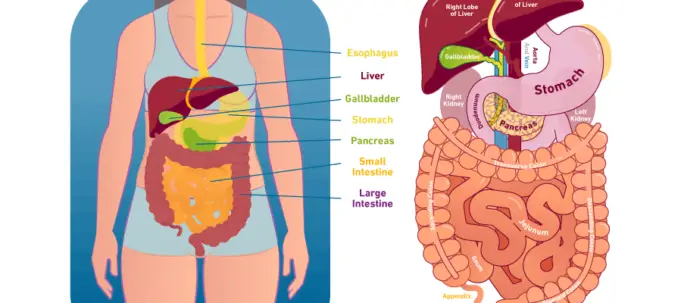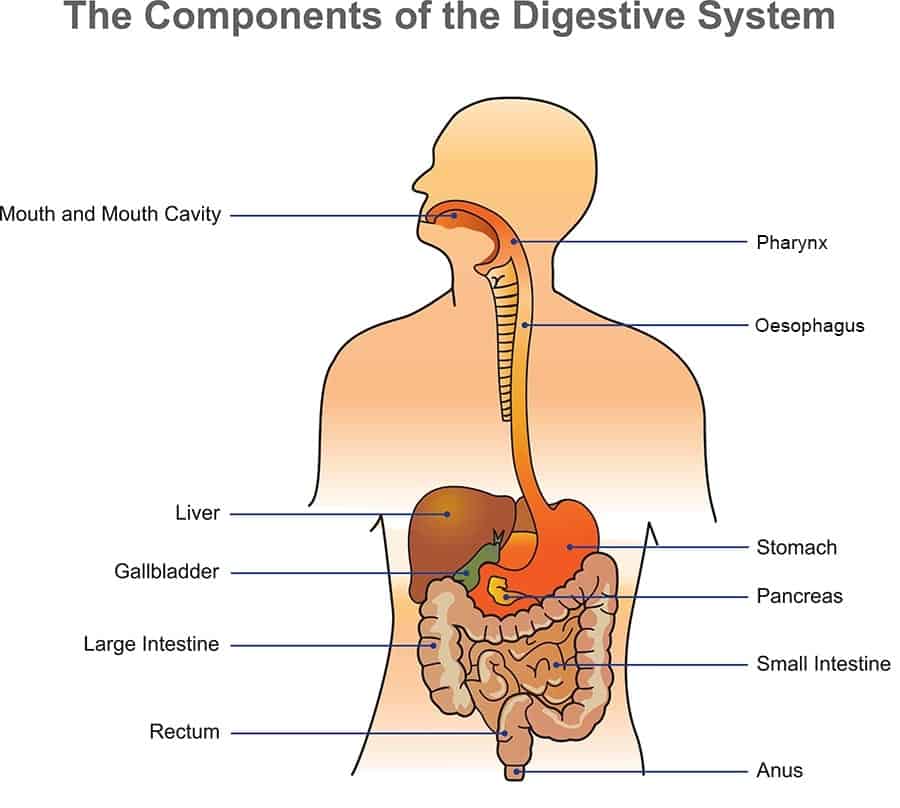Do you ever wonder what happens when you put food in your mouth? What are the processes through which the food we consume gives us energy? Your digestive system performs an essential task every day, so whenever you eat those copious amounts of burgers, this is what happens.
Digestion is the breakdown of food material into smaller units that can be easily absorbed by the body, and the digestive system aids this activity. The human digestive system consists of the digestive or gastrointestinal tract, the liver, pancreas, and the gallbladder.
The digestive tract is made up of a series of hollow and twisting tubes that start from the mouth down to the anus. The hollow organs are the mouth, the esophagus, stomach, small intestine, large intestine, and the anus.
For digestion to take place, gastric juices would be release at the sight and smell of food in the stage called the cephalic phase. This would be followed by the breakdown of food by chewing and the digestive enzymes present in the saliva.
The masticated food is then forced through the esophagus down into the stomach by the action of peristalsis – the synchronized contraction of muscles in the esophagus.
The food bolus becomes chyme – a thick creamy fluid – as leaves the stomach and enters the small intestine. Here, nutrients are absorbed by the small intestine, and water and some minerals are reabsorbed from the large intestine.
The solid waste left is transported to the colon where it sits and waits for ejection through the anus as fecal matter. The digestive system obtains nutrients from food through the following activities
- Ingestion: This is the taking in of food through the mouth
- Mechanical digestion: The breaking down of food into smaller bits and the churning and mixing motion of food that occurs in the stomach.
- Chemical Digestion: The mixing of food with enzymes in the stomach to synthesize nutrients like carbohydrates, proteins, and fats present in the food. The action of enzymes on these nutrients.
- Movement: This describes the movement of food bolus from the mouth through the esophagus and into the stomach. It is the repetitive churning of by the contraction of the stomach muscles to form chyme.
- Absorption: Nutrients from food molecules are removed by the cells lining the small intestine and taken into the bloodstream in a process called absorption.
- Egestion: This is the removal of waste products obtained from the digestion of food.
Several conditions that could affect the performance of the digestive system include indigestion and diarrhea.
The Digestive Pathway
The Mouth
The mouth begins the digestive system. With the aid of the tongue and teeth, digestion starts as soon as food enters the mouth. Chewing is the mechanical process by which food is broken down into smaller bits by the grinding action of the teeth.
The salivary glands on the tongue release saliva, which contains the digestive enzymes lipase and amylase. These further breaks down the food in the mouth. This masticated food (bolus) moves down the esophagus by the rhythmic movement of the muscles.
The Esophagus
This is a hollow, muscular tube that begins from the mouth and ends in the stomach. Situated in the throat near the windpipe, the esophagus receives food from the mouth when swallowed.
A muscular ring called the cardiac sphincter is located at the end of the sphincter. This controls the opening and closing of the esophagus and trapping food in the stomach. Movement of food in this organ occurs by the action of peristalsis.
The Pancreas
This organ secretes enzymes necessary for digestion into the duodenum, the first section of the small intestine. Fats, proteins, and carbohydrates are broken down by these digestive enzymes.
The pancreas also produces insulin – a hormone that allows the body to use and store sugar from carbohydrate – secreting it directly into the bloodstream.
The Liver
The liver is a meaty organ that performs several functions. In the digestive process, its principal function is to screen the nutrients absorbed from the small intestine.
It also produces bile, a substance that neutralizes the highly acidic chyme from the stomach. This is secreted into the liver from the gallbladder and plays a vital role in the digestion of fats.
The Gallbladder
This is the organ used to store bile produced by the liver. It releases it into the duodenum and helps in absorbing and digesting fats.
The Stomach
This organ is one of the major organs in the digestive system. Located in the abdominal cavity, it is a muscular sac that collects food from the esophagus.
It produces gastric juice containing hydrochloric acid and sodium chloride, which plays a significant role in the process of digestion. Cells lining the organ stimulates the production of the gastric juices.
Through peristalsis, the churning and mixing food bolus with digestive enzymes and juices occurs. This mechanical action results in the production of chyme, a thick creamy fluid that is sent to the small intestine where digestion and absorption continues. The stomach can expand in size to contain a liter of food in adults.
The Small Intestine
The small intestine is a 21-foot long muscular organ that is made up of three sections – the duodenum, the jejunum, and the ileum.
The small intestine further digests chyme transported from the small intestine. This is further broken down by the duodenum through the action of peristalsis. The chyme is very acidic due to the low pH conditions in the stomach.
Therefore, the pH in the small intestine must be at the optimum condition to activate digestive enzymes. To achieve this, bile from the gallbladder and digestive secretions from the pancrease is mixed with the chyme to reduce its acidity.
Following this, the digested mixture is sent to the jejunum and ileum where the essential nutrients are absorbed into the bloodstream by cell lining in their walls.
The Large Intestine
The large intestine is a 6-foot muscular tube connected to the small intestine and ends in the rectum.
A small pouch called the cecum indicates the division between the small and large intestines. The large intestine is composed of the ascending colon, the transverse colon, the descending colon, and the sigma colon.
The large intestine is responsible for the fermentation of digested particles by the gut flora, and the time taken varies from one person to another.
Waste from the digestive process is passed through the sections of the large intestine through peristalsis. Water is removed from the waste when it passes through the colon to solidify the waste.
The Rectum
The function of the rectum is to receive and store solidified waste from the colon until it is ready to be egested via the anus. This usually occurs once or twice a day.
The Anus
The anus is the final part of the digestive system. It is a canal consisting of the internal and external anal sphincters and pelvic floor muscles. The muscles in the anal walls control the movement of stool.
The internal sphincter is a tight muscle that inhibits the involuntary egestion of stool. The external sphincter holds the stool until it can be appropriately released.













